The 2016 Razer Blade Pro Review
by Brandon Chester on March 6, 2017 8:00 AM EST- Posted in
- Laptops
- Razer
- Razer Blade Pro
GPU Performance
The headline feature of the 2016 Razer Blade Pro is definitely its use of NVIDIA's GTX 1080 GPU. NVIDIA's Pascal generation of GPUs has brought us to the point where you really can get essentially the same GPU performance from a laptop as a desktop, although the base clock speed is slightly lower than its desktop counterpart, and thermals can play a large role in laptop performance. GTX 1080 is still NVIDIA's flagship GPU, and the Blade Pro is the first machine I've seen with it that isn't a ridiculously bulky desktop replacement laptop.
In theory, using GTX 1080 does get you about the same performance as a desktop with the same GPU, but as I mentioned before, thermal constraints can cause a gap in performance. Other factors like the speed of the CPU can also have an impact, so it's important to properly evaluate the Blade Pro even though knowing the specifications already provides an idea of how well it will perform. With that in mind, I've run the Blade Pro through our standard GPU workflow for laptops.
3DMark
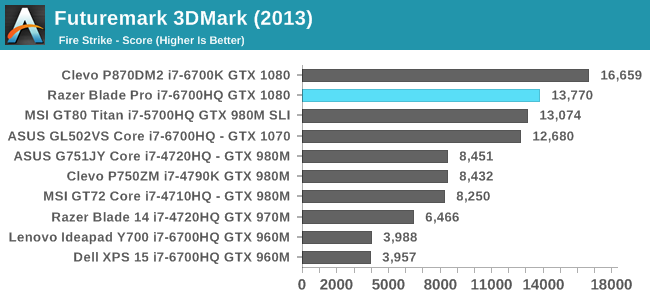
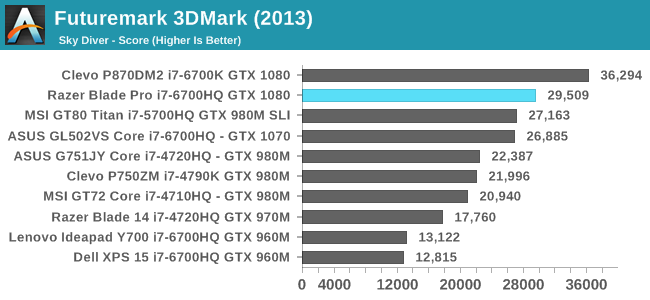

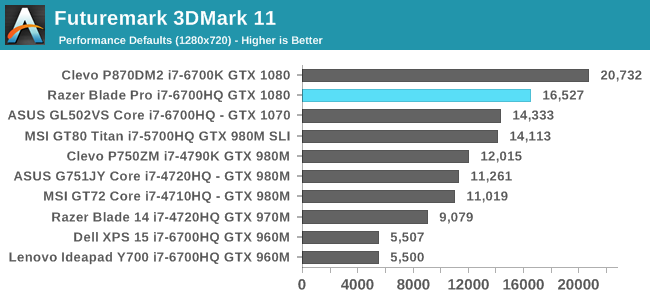
3DMark has evolved over the years to match the increasing performance of GPUs. In the newer, more GPU-intensive tests like Fire Strike, Sky Diver, and Cloud Gate, the Razer Blade Pro is right near the top of the chart. In Fire Strike and Sky Driver it wins against the MSI GT80 with it's dual GTX 980M GPUs, but it comes in a bit lower in Cloud Gate. The Clevo P870DM2 always comes in first as a result of its faster desktop CPU, which isn't unexpected. Overall, 3DMark shows the strong performance of NVIDIA's GTX 1080 and the Blade Pro.
GFXBench
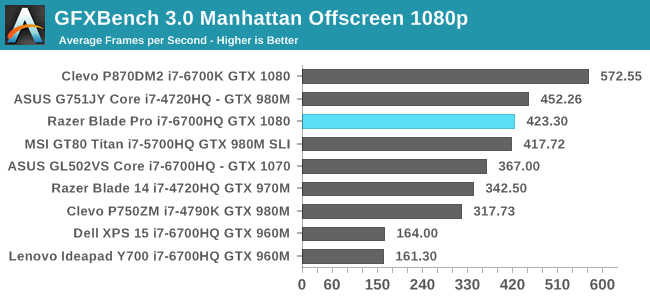

GFXBench basically exists for testing lower-performing laptops, as well as to verify that nothing is wrong with a laptop's performance for OpenGL titles. The Blade Pro performs as expected in both cases, sitting between the Clevo P870DM2 and the ASUS ROG Strix.
Dota 2 Reborn

Dota 2 is really CPU-bound at this point, with all the 6700HQ-based laptops achieving similar levels of performance. While the Blade Pro is at the same level as ASUS's GTX 1070 ROG Strix, the Clevo P870DM2 with its i7-6700K is nearly twice as fast as the Blade Pro despite using the same GPU. Ultimately this situation isn't unexpected for Dota 2, and the Blade Pro won't have any trouble with it even if the resolution is increased beyond the 1080p resolution that we test at.
Tomb Raider

Tomb Raider is perhaps the best showing for the Blade Pro, with performance being very close to that of the Clevo P870DM2, and significantly faster than any of the other laptops that we've tested.
Rise of the Tomb Raider

Rise of the Tomb Raider is a newer addition to our benchmark suite, so there aren't many results at this point. However, the order of the top results here mirrors the previous Tomb Raider test, with the Clevo P870DM2 at the top, followed by the Blade Pro, and the ASUS ROG Strix coming in third.
Civilization VI



Civ VI is a relatively new addition to the benchmark suite, and the only other laptop on record is the ASUS ROG Strix. As usual, Civ remains a more CPU-bound title, and with the same i7-6700HQ the Blade Pro performs essentially the same as the ROG Strix despite the difference in GPUs. Using one of Intel's faster CPUs would have helped differentiate the Blade Pro from other laptops in these CPU-bound titles, which would have avoided the awkward situation where a $3700 laptop doesn't perform any better than one which is less than half the price.
Bioshock Infinite
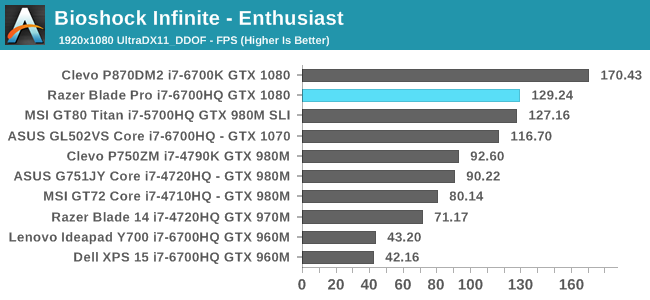
Bioshock Infinite is a case where the Blade Pro falls pretty far behind the Clevo P870DM2. I actually find the result of the P870DM2 to be somewhat questionable, as it seems higher than I would think is possible, so I can only assume that it must have been a really lucky run. In this case the Blade Pro performs slightly better than the MSI GT80 with its pair of GTX 980M GPUs, which is still quite a feat.
Dragon Age: Inquisition
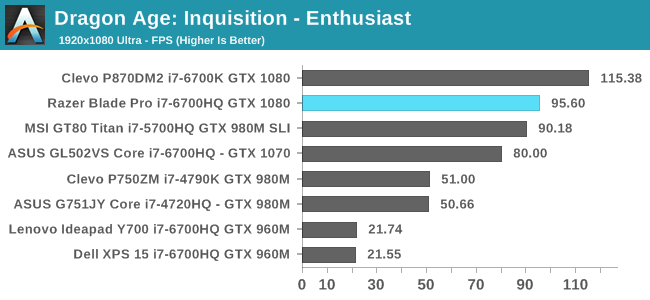
Dragon Age: Inquisition is one case where the Blade Pro is actually closer to the ASUS ROG Strix with its GTX 1070 than the Clevo P870DM2 which also uses GTX 1080. This is really something that depends on the game, and whether there are situations where the CPU becomes the limiting factor for performance. The performance is still significantly better than the GTX 1070, and noticably faster than a pair of 980Ms.
Shadow of Mordor
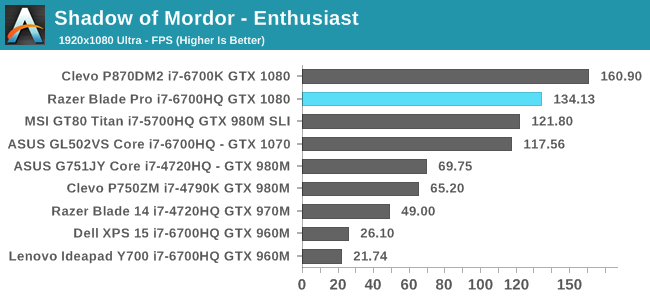
The Blade Pro performs well in Shadow of Mordor, although this is another case where the frame rate is slightly closer to that of the ASUS ROG Strix with its GTX 1070 GPU than the Clevo P870DM2. Still, the performance is quite impressive, especially when you consider how the Blade Pro is again surpassing the performance of the MSI GT80 which used a pair of GTX 980M GPUs and was the performance leader for laptops until the launch of NVIDIA's Pascal parts.
Grid Autosport
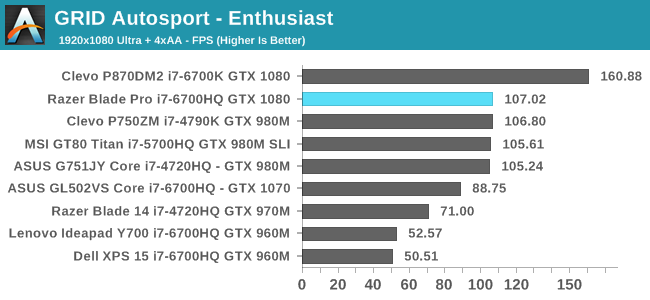
GRID is another case where machines become CPU limited at our test settings. The Blade Pro sits alongside several other laptops with lesser GPUs, while the Clevo P870DM2 has a large lead because of its desktop i7-6700K CPU. While Razer couldn't have put a 91W desktop CPU in their laptop, using a faster quad core mobile part could have improved performance here.
GPU Conclusion
When I first looked into gaming laptops many years ago as an interested consumer it was typically the case that NVIDIA's mobile parts reflected the performance of the GPU three tiers below that of the desktop card with a matching name. The performance that you can achieve in a notebook has gone up substantially since that time, and we're now seeing what are basically desktop parts shipping in laptops. In the case of the Razer Blade Pro, you have NVIDIA's GTX 1080, which is their flagship card for notebooks.
In the tests above it's clear that the Razer Blade Pro is one of the fastest notebooks on the market. The GTX 1080 provides a substantial increase in performance compared to laptops like the ASUS ROG Strix which use GTX 1070. However, if you were expecting the same performance as Clevo's P870DM2 you may be feeling somewhat left down. I was initially suprised by the gap, especially with the Razer Blade Pro being closer to the ROG Strix than the P870DM2 in some situations. After some examination, I've concluded that there isn't really any GPU throttling occuring, and looking at the titles where the gap is largest makes it evident that we're seeing the impact of differing CPUs. The Blade Pro's 2.6GHz i7-6700HQ is no slouch, but it's not going to keep up with a 4GHz i7 sitting in a desktop replacement that's twice as thick.
While this situation is unavoidable, there are two things I want to highlight. The first is that Razer could have, and should have used i7-6920HQ. I mentioned that on the previous page, and it bears repeating here. The Blade Pro is a premium laptop that starts at $3699. It's a machine that spares no expense, and it should be using Intel's fastest quad core chip. This would help in narrowing the gap between it and the P870DM2, and I'm pretty sure Razer would still bring in a healthy margin on the laptop.
The other point I wanted to mention is that the gap between the Blade Pro and the P870DM2 will be diminshed when running games at UHD. At that point the GPU becomes the limiting factor, and the difference in CPU performance has a smaller impact. Unfortunately, a single GTX 1080 really isn't sufficient to run modern titles at UHD unless you reduce the graphical settings to a point where the game probably looks worse overall than it did maxed at 1080p.
Ultimately, the Razer Blade Pro is still an incredibly fast machine, and 1080p is a perfectly suitable resolution to run games at on a 17-inch display. For example, I played through Deus Ex: Mankind Divided at max settings on the Blade Pro at 1080p and I was never bothered by scaling artifacts or aliasing. For $3699 I think Razer should have put in the fastest possible CPU in order to maximize performance, but as it is the Blade Pro is still highly capable and should be able to run modern games at high settings for the forseeable future.










57 Comments
View All Comments
fanofanand - Monday, March 6, 2017 - link
I bought my wife a cheap $350 Acer (because she doesn't know the difference) and despite her repeated attempts, she has been unable to destroy it. Plastic is not premium, but is great when you are building things to a price point. Most consumer electronics sold are not the top-end gear.BrokenCrayons - Monday, March 6, 2017 - link
I think the part I don't like about plastic laptops are those metal-in-plastic screw fittings where there's a little threaded cylinder for the screw that has that knotty outside and get stuffed into a hollow plastic tube. (No idea what the technical name for those things are.) The plastic sometimes will crack around them and the screws along with the threaded cylinder thingies will break free.Barilla - Monday, March 6, 2017 - link
Ok, just to clarify - I have no issue with this laptop being made of aluminium, I even agree it's a good choice, although if I wanted to be picky, there are carbon fibre materials with thermal conductivity equal to or higher than aluminium.I meant it on a more general level as your comment about carbon fibre mentioned Dell XPS, which in it's 13" version houses a 15W CPU and no dGPU, which means it needs to dissipate at most 1/10th the heat this laptop does.
Really, nothing against aluminium. Or magnesium either, as I'm typing this comment from a Surface. All I'm saying is that plastic, and especially carbon fibre, is a perfectly fine material in many - not all - applications, including some laptop and smartphone chassis.
Peace.
Azurael - Monday, March 6, 2017 - link
I wonder whether people will ever get beyond that 'it looks more premium' mindset with CFRP (or even polycarb) vs. metals. Personally, I'd prefer to be able to buy 'plastic' versions of any portable electronics for impact resistance, metal devices are far too easy to dent and break. It's all very well having a metal phone or laptop, but if you have to keep it in a plastic/rubber case all the time to keep it safe, I don't see the point.simonm - Monday, March 6, 2017 - link
Carbon fibre is strong but to the best of my knowledge not usually a good conductor of heat except for certain specialised versions.So unless Razer went with some kind of super carbon fibre the case won't be able to facilitate cooling (like an extended heat sink) as well as if it were aluminium. I doubt Razer did use a high conductivity fibre or they'd be marketing the hell out of that.
Instead they chose it probably for its high strength/rigidity to weight ratio, lower cost than aluminium and marketing because it sounds cool and high end.
If money (and weight) wasn't an option you could use lots of metal alloys that are more conductive than aluminium. Copper... gold ;)
simonm - Monday, March 6, 2017 - link
Correction: change option to issue!PS: So I think most people are looking down on the CF for its thermal properties when compared with aluminium. Aluminium offers good weight and thermal properties but with high expense and lower hardness/rigidity than carbon fibre.
With a 1080 packed in there and a 180 W power adapter I reckon you'd want as much help dissipating heat as you can get. So carbon fibre seems like something of a compromise.
colonelclaw - Monday, March 6, 2017 - link
Surely carbon fibre is much more expensive than aluminium? That's the impression I always got from products that use it, or is that just marketing?fanofanand - Monday, March 6, 2017 - link
Carbon Fiber (the high-tech variety) is far more expensive than aluminum.Bullwinkle J Moose - Monday, March 6, 2017 - link
if money (and weight) wasn't an option.....Diamond plated Silver would be a far better thermal conductor than Copper or Gold
Diamond has 3X the thermal conductivity of even silver
But a diamond frost coat on copper would look better
A Rose Gold that costs as much as real Gold
Sound like an Apple Product!
SkipPerk - Wednesday, April 19, 2017 - link
In order to plate the silver to make it strong enough I think it would interfere with the thermal transfer. I think nickel-plated copper would be the better choice, although it would still be soft. Aluminum really is the best choice.